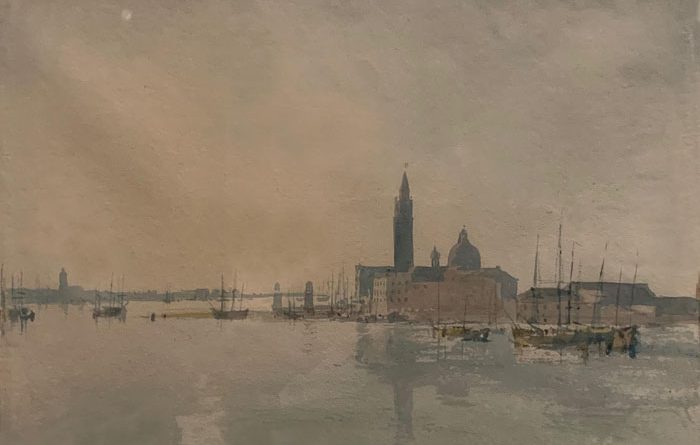Landscape Painter J.M.W. Turner
Jackie and Sherrie discuss landscape painter J.M.W. Turner
Join The Artists Guild for Free to Watch the Video.

Jackie: Hi Sherrie.
Sherrie: Hi Jackie.
Jackie: How are you?
Sherrie: I am excited today to talk about Turner!
Jackie: I am too! He is definitely a favorite landscape painter of all time. I think that his concept and ideas about painting are really so in sync with the way we teach and the way we think about our own paintings. Even today, where he painted during the late 1700’s and early 1800’s, before the impressionists, his work really holds up. In the face of many different painting periods. I think that his work as a landscape painter has just held up. So, I know that you have just come back from Mystic, Connecticut where you got to see a bunch of his work that hadn’t been shown, I think, for a long time.
Sherrie: No, I think they have. I’m pretty sure it came from the Tate Museum.
Jackie: Oh, the Tate! Was it a smaller collection of watercolors?
Sherrie: Watercolors and oils.
Turner at the Mystic Seaport Museum
Jackie: Why don’t you tell us what you saw!
Sherrie: Well, they started with some of his early watercolors which I had never seen. And to be quite honest, they were kind of boring to my eye. And I am guessing from what I gleamed, is that the way he was doing watercolor was the way it was traditionally taught in England. Certainly, English painters are really known for watercolors. A friend of mine has the most gorgeous English watercolor landscape that is just spectacular. So, they really did know the genre.
But I was interested to see that even in these early kinds of boring paintings, that there was one painting where I felt like one area of it he started to get a sense of what he could do with watercolor. It was just like a reflection of the moon in the water. And it was just something beautiful about the way everybody has their handwriting. And it was just kind of his handwriting. In the exhibit you could really see that quality start to blossom. Start to grow and develop.
Turner’s “handwriting”
Sherrie: What was nice was that they also mixed in some oils as well, of the ships and smoke. It was really just phenomenal to see. While I’ve seen quite a few exhibits of Turner’s watercolors as a landscape painter, and while maybe this one didn’t have that many exceptional watercolors in it, they had some that were so abstract. For example, there was this one that had a detail in it of this whale that was just a few brushstrokes. Yet you still somehow know it’s a whale. It’s so little that he’s put down. So, it’s just the way he thought about it that I think was really unusual.
And I know that the thing that speaks to you, me, David and Stacy about Turner, is that abstract quality. That he really thought conceptually. And was exploring the quality of paint. Just what you were saying. Just really exploring paint in a way that was completely innovative for the time.
How Turner Painted as Landscape Painter
Sherrie: They didn’t have a catalog for the show. It’s a small museum, but they did have something that was written by this conservator from the Tate. She’s been at the Tate for quite a while. Her name is Joyce Townsend and she wrote How Turner Painted. So, it’s about his materials and techniques. This is something a conservator would really know about. I haven’t read the whole book since it’s quite a beautiful book and I haven’t gotten past ogling the paintings and all of that!
Jackie laughs.
Sherrie: I’ve just read a little bit of it, but I think it should be a pretty interesting read. Especially if you are interested in either watercolor or oil. And it gives you some sense of who he was as a human being. Certainly, if you look at the paintings themselves, they are really powerful. I was glad I got to see it!
Turner’s subject matter
Jackie: Were you impressed by the subject matter that he chose? During his lifetime, there weren’t many painters who painted the big landscape, the large horizon. I’m thinking particularly of his Venice scenes. Or just his big empty spaces with little buildings. It was very interesting that he used the subject matter to accomplish what he wanted to conceptually convey.
Sherrie: Plus, what I think is so interesting about Turner is that he had some architectural background. This shows that it’s like each person, depending on who they are or what their interests are, will be drawn to doing certain things. So, in his case, he was drawn to buildings. You know, I have to say, he wasn’t the greatest draftsman in terms of people. It’s always a little bit weak when people are in the painting. But in terms of his understanding of his perspective and him being drawn to the beauty of these buildings…so yeah, his Venice watercolors are just gorgeous!
Turner’s luminosity
Jackie: There’s luminosity to his work that I think just lived and died with him.
Sherrie: Well, I wouldn’t say that…
Jackie: (laughs) Not entirely! But for hundred of years, we didn’t see anything like that. I’m thinking of through the period of the impressionists and the abstract painters in the 20th century.
Sherrie: Well, that’s a good point, yeah.
Jackie: We sort of lost that luminosity of the quality of the paint. That he had discovered and then was sort of lost for a long time.
Sherrie: Yes, I understand. You are the art historian by comparison to me!
Jackie: But I think people like, well you and David. Particularly David, there was something that he was really drawn to. I think early on – the luminosity of the paint and capturing that light, making that a large concept in his work. And that was Turner’s huge…you don’t want to say, “coming out of the shadow”, but in a way it was.
Sherrie: Yes, very interesting. So, I think if anybody is interested, they should try to get this book from the Mystic Seaport Museum in Connecticut. And you should check into Turner because he really was one of the great painters in the history of art.
Jackie: Thank you, Sherrie McGraw – another great painter of our time!
Sherrie: Thank you! And thank you guys for reading. I hope this was helpful!
To learn more about how you can become a member and access 100-300+ world-class painting and drawing classes, visit The Artists Guild.





Leave a Reply
You must be logged in to post a comment.